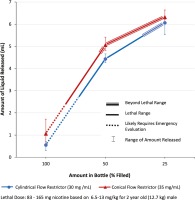Dear Editor,
Teenage vaping has become so prevalent that the U.S. Surgeon General has labeled it an epidemic. Among teens who vape, 85% use flavored e-cigarettes1, many of which contain numerous toxic constituents as well as nicotine2. The FDA bans fruit-flavored nicotine cartridges but places no flavor restrictions on liquid nicotine for refillable devices3. Bottles of flavored nicotine have coloring, names, and designs that liken them to children’s candy4. From 2013–2017, US hospitals treated 4745 children aged <5 years for liquid nicotine related poisoning5.
Federal regulations require liquid nicotine bottles to have flow restrictors that limit liquid release if children squeeze a bottle, but regulations do not address liquid release if children suck on one6. ASTM International has published testing procedures that replicate children sucking from bottles with flow restrictors7. A 2020 study found sucking released 7.5-fold more liquid from bottles with flow restrictors than squeezing8. We sought to determine the amount of liquid that could be released if children try to suck on a liquid nicotine bottle.
Two flow restrictor designs (conical, cylindrical) are predominantly used. Three samples of two brands of 30 mL bottles, representing each design, were purchased. To simulate a child sucking, full, half-filled (15 mL), and quarter-filled (7.5 mL) bottles were placed downward inside a vacuum chamber. A pump applied negative pressure (21.0 ± 0.4 kPa) for 30 seconds, representing the force of a child sucking according to ASTM testing procedures6. Each bottle’s mass was recorded before and after testing, and the liquid’s density was used to convert the amount released to mL. The average nicotine released was compared to lethal nicotine doses (6.5–13.0 mg/ kg) for an average 2-year-old (12.7 kg) male8.
On average, cylindrical flow restrictor bottles released 0.6 mL (range: 0.4–0.8), 4.4 mL (range: 4.2–4.6), and 6.1 mL (range: 5.9–6.2) of liquid nicotine when full, half-filled, and quarter-filled, respectively. Conical flow restrictor bottles released 1.1 mL (range: 0.5–1.8), 5.1 mL (range: 4.7–5.3), and 6.3 mL (range: 6.0–6.6) of liquid nicotine when full, half-filled, and quarter-filled, respectively. The average nicotine released by filled cylindrical (30 mg/mL) and conical (35 mg/mL) bottles (16.6 mg, 37.2 mg) was not lethal for an average 2-year-old male. As expected by Boyle’s Law, amounts released by half-filled (133 mg, 177 mg) and quarter-filled (182 mg, 221 mg) bottles were greater and within or above lethal range (Figure 1). While only mechanical testing was conducted, human testing could be performed in subsequent studies and enhanced surveillance of nicotine exposures should continue9.
To prevent nicotine poisonings, safety standards must consider children sucking on bottles, and that bottles may be partially filled. We tested bottles comparable to the lowest popular cartridge concentration (30 mg/mL); higher concentrations (≥50 mg/mL) are more popular, and ingestion would be lethal in smaller volumes. FDA guidance recommends bottles of certain liquid medications, like acetaminophen, have ‘closed’ flow restrictors (e.g. valves or silicone plugs that syringes must puncture)10. Such guidance should apply to liquid nicotine, which is far more toxic at significantly lower doses.


